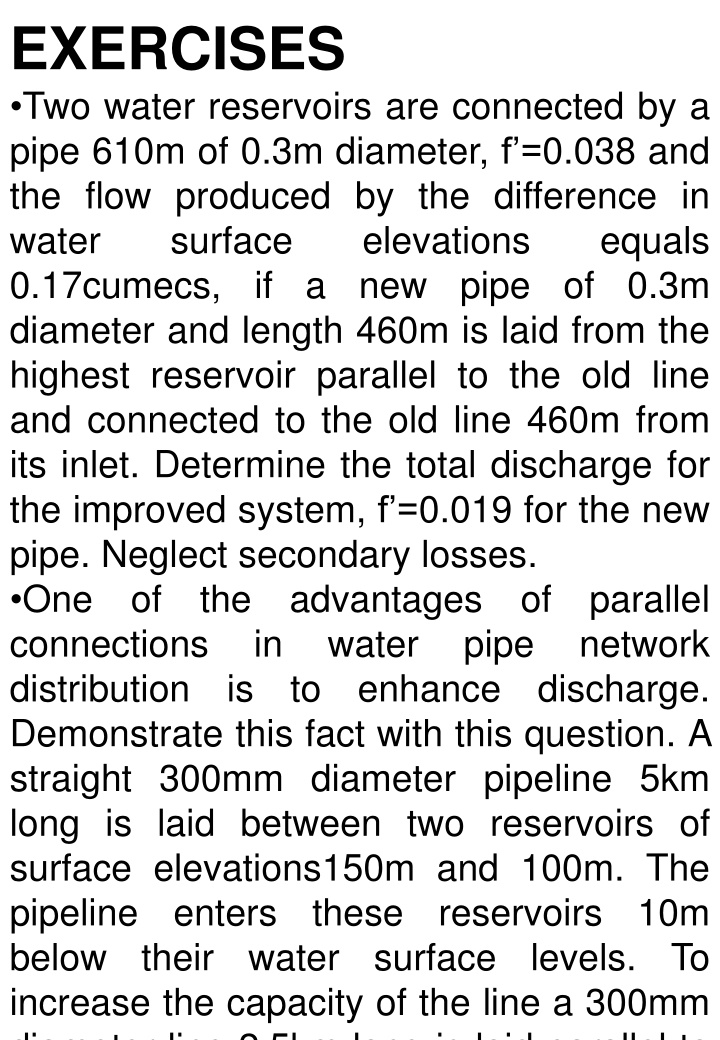Water Pipeline System Design and Analysis Exercises
This exercise set explores various scenarios related to water pipeline systems, including connecting reservoirs, parallel and series connections, flow rate calculations, friction losses, power requirements for pumping, and more. The exercises cover topics like pipe diameter, length, friction factors, flow rates, pressure losses, and pump efficiency. Students can practice applying fluid mechanics principles to design and optimize water distribution systems.
Download Presentation

Please find below an Image/Link to download the presentation.
The content on the website is provided AS IS for your information and personal use only. It may not be sold, licensed, or shared on other websites without obtaining consent from the author.If you encounter any issues during the download, it is possible that the publisher has removed the file from their server.
You are allowed to download the files provided on this website for personal or commercial use, subject to the condition that they are used lawfully. All files are the property of their respective owners.
The content on the website is provided AS IS for your information and personal use only. It may not be sold, licensed, or shared on other websites without obtaining consent from the author.
E N D
Presentation Transcript
EXERCISES Two water reservoirs are connected by a pipe 610m of 0.3m diameter, f =0.038 and the flow produced by the difference in water surface elevations 0.17cumecs, if a new pipe of 0.3m diameter and length 460m is laid from the highest reservoir parallel to the old line and connected to the old line 460m from its inlet. Determine the total discharge for the improved system, f =0.019 for the new pipe. Neglect secondary losses. One of the advantages of parallel connections in water distribution is to enhance discharge. Demonstrate this fact with this question. A straight 300mm diameter pipeline 5km long is laid between two reservoirs of surface elevations150m and 100m. The pipeline enters these reservoirs 10m below their water surface levels. To increase the capacity of the line a 300mm diameter line 2 5km long is laid parallel to equals pipe network
Calculate the ratio of the total flow rates for the case in which the pipes are connected in series compare to the case in which the pipes are in parallel. The density of water can be taken as 1000kg/m3. Two long pipes are used to convey water between two reservoirs whose water surfaces are at different elevations. One pipe has a diameter twice that of the other. If both pipes have the same value of friction factor and if minor losses are neglected, what is the ratio of the flow rates through the two pipes A 2.0m diameter concrete pipe of length 1560m for which =1.5mm conveys 120C water between two reservoirs at a rate of 8.0m3/s. What must be the difference in water surface elevation between the two reservoirs? For the diagram below and the information in the table below. Pipe Length L (m) Diameter D (m) f 1 2 3 150 200 75 10.0 7.5 5.0 0.0275 0.0245 0.0315
Pipe No 1 2 3 4 5 Diameter (mm) Length (m) f 200 300 450 300 300 300 300 300 600 700 0.021 0.0185 0.0165 0.0185 0.0185 64 '= f Re =0.25mm, what is Q? 7) (a) For laminar flow in pipes Find the equivalent length of a 300mm diameter clean cast iron pipe to replace the above system. For H=10m, . Using this information, develop the expression for the velocity in terms of lost head due to friction, diameter and other pertinent items. (b) How much power is lost per meter of pipe length when oil with a viscosity of 0.20N.s/m2 flows in a 20cm diameter pipe at 0.5L/s. The oil has a density of 840kg/m3. (c) Oil of absolute viscosity 0.1Pa.s and relative density 0.85 flows through 3048m of 305mm cast iron pipe at the rate of 44.4x10-3m3/s. What is the lost head in the pipe? 8) Water is pumped 15Km, from a reservoir at elevation 30m to second reservoir 64m. The pipeline connecting the reservoirs is 1.5m in diameter. It is concrete and has an absolute roughness of 0.9mm. If the flow is 109L/s and pumping station efficiency is 80%, what will be the monthly power bill if electricity costs 30kobo per kilowatt hour? (f =0.0175).
9) It is necessary to pump 0.38m3/s of water from reservoir at an elevation of 270m to a tank whose bottom is at an elevation of 330m. The pumping unit is located at elevation 270m. The suction pipe is 0.6m in diameter and very short so head losses may be neglected. The pipeline from the pump to the upper tank is 123m long and is 0.5m in diameter. Consider the minor losses in the line to equal 0.75m if water. Find the maximum lift of the pump and the power required for pumping if the pump efficiency is 76%. The maximum depth of water in the tank is 11.4m and the supply lines are cast iron, f =0.017.























